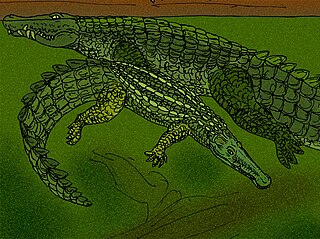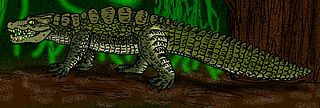 W
WMekosuchinae is an extinct subfamily of crocodylids from Australia and the South Pacific. They first appear in the fossil record in the Eocene in Australia, and survived until the arrival of humans: in the Pleistocene in Australia and within the Holocene in the Pacific islands of Fiji, New Caledonia and Vanuatu. There is however disagreement on whether or not Mekosuchinae is a true subfamily within Crocodylidae, or a distinct crocodilian family in its own right, Mekosuchidae, within the superfamily Crocodyloidea.
 W
WBaru is an extinct genus of Australian mekosuchine crocodilian. It was semi-aquatic, around 4 m (13 ft) in length. Being semi-aquatic its habitat was around fresh pools of water in wet forests, ambushing their prey, much like modern species. The word Baru is Aboriginal and means "crocodile's ancestor".
 W
WHarpacochampsa is a poorly known Early Miocene crocodilian from the Bullock Creek lagerstätte of the Northern Territory, Australia. The current specimen consists of a partial skull and fragments of a slender snout reminiscent of that of a false gharial. It is tentatively placed within Mekosuchinae, though some experts disagree with this, as H. camfieldensis would be the only known mekosuchine with a long, thin snout. Its long snout demonstrates that it was a piscivore in life.
 W
WKambara is an extinct genus of mekosuchine crocodylian that lived during the Eocene and Oligocene epochs in Australia.
 W
WMekosuchus is a genus of extinct Australasian crocodiles within the subfamily Mekosuchinae. They are believed to have been made extinct by the arrival of humans on the South Pacific islands where they lived. The species of this genus were small in size, 2 m in maximum length, and terrestrial, making them the last surviving group of fully terrestrial crocodilians, leaving only semi-terrestrial species such as the Cuban crocodile and the dwarves Osteolaemus and Paleosuchus.
 W
WTrilophosuchus is an extinct genus of mekosuchine crocodilian from Australia. Unlike living crocodilians, it is hypothesized to have been terrestrial. Trilophosuchus was approximately 1.5 metres (4.9 ft) in length. It had a short skull with three ridges on top and large eyes. Fossils have been found at Riversleigh in north-western Queensland, and are Miocene in age. Only a single species has been described, the type species T. rackhami.
 W
WVolia is an extinct genus of mekosuchine crocodylian from Fiji. It was around 2–3 metres (7–10 ft) long. Notwithstanding its comparatively small size, it was probably the apex predator of the Pleistocene ecosystems of Fiji.